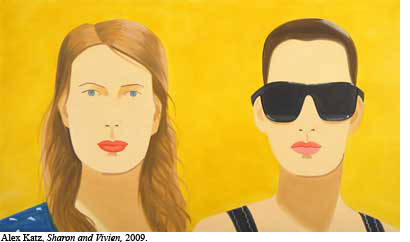Alex Katz: New Work
Farnsworth Art Museum • Rockland, ME • www.farnsworthmuseum.org • Through January 2, 2011
Alex Katz is one of America’s best-known modern artists for reasons that are readily apparent in this show of new, large paintings at the Farnsworth Art Museum in Rockland.
In the 1950s when Katz was coming of artistic age, an important question was whether representation could be reconciled with the discoveries of postwar modernist abstraction. Katz found a particular way to use modernist ideas about flatness to reduce the pictorial space of representational painting to a minimum, using large areas of color and very little modeling. He wasn’t the only artist to do this, but he did it with a distinctive individual style. The color regions are flat and unmodulated, fitting neatly into modernist thinking about the tension between the actual flatness of a canvas and the illusion of pictorial space.
His style was validated by later trends. Art audiences that were put off by the austerities of minimalism or the cruel ironies of pop could still be part of the modern world—they could still like a Katz painting.
 In the twelve-foot painting Sharon and Vivien (2009), the faces of the two women fill the canvas, placed against a flat yellow background. There’s just enough shading to delineate their features as they look out at the viewer. The effect is one of detached coolness, offering little emotional expression. Yet Katz has a way of impressing his own identity onto their simplicity. In this way he resembles Sargent, depicting a social milieu through the lens of his individual artistic sensibility—no one else could have done these.
In the twelve-foot painting Sharon and Vivien (2009), the faces of the two women fill the canvas, placed against a flat yellow background. There’s just enough shading to delineate their features as they look out at the viewer. The effect is one of detached coolness, offering little emotional expression. Yet Katz has a way of impressing his own identity onto their simplicity. In this way he resembles Sargent, depicting a social milieu through the lens of his individual artistic sensibility—no one else could have done these.
Several works relate directly to Monet’s late water lily paintings. In the large Homage to Monet 8, flat yellow ovals suggesting lily leaves float across the picture against a solid dark background. Passages of even gray, across the bottom, suggest the reflection of the sky and trees. The homage is not so much to Monet’s style—these are very different—but to the liberty Monet’s vast experience provided and the integrity of his results. Katz’s identity is distinct from Monet’s, and it has always been his. His homage is not to Monet’s style but to the nature of his life in art.
—Ken Greenleaf
